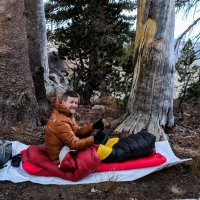Embraced by the Strangler Fig
|
Outside magazine, November 1995
After surviving a hideous car crash in 1980, my friend Tucker Comstock experienced a spiritual refurbishment that helped her shed society's mean limitations and jettisoned her free into a life filled with astonishments of her own choosing--a transcendent journey that would be easier to appreciate if she didn't insist on dragging the rest of us along with her. "Gad!" I once told her. "The world was a much safer place when you were confined to a wheelchair." "Quit whining," she replied. "Remember: The world was also a hell of a lot more boring." It is a point that her friends won't argue. Tucker Comstock can tolerate anything but boredom. Preserved within her is a loony sanctuary of inexhaustible expectation. If something interesting hasn't happened by noon, she jumps into her Land Cruiser and goes looking for it. Any activity, no matter how ridiculous, is preferable to inaction. Yet even I was surprised when, not long ago, she called and invited me to climb a tree with her in a Costa Rican rainforest. "Don't say no until I've told you about it," she demanded. "This is an amazing tree. It's a hollowed out strangler fig way back in the rainforest. You climb up on the inside--70, 80 feet up. You know the best thing? There are bats in it." Only Tucker Comstock would consider bats an attribute. Tucker is 51 years old. She is five and a half feet tall and weighs 180 pounds. She has hair like Mary Travers and a nose like Joe Palooka. Because of the car crash (she swerved to miss a dog and hit a bridge), her right ankle and her right wrist are fused. Her balance is bad, and her mobility is limited. By her own description, the injuries cause her to walk like a bear. Before the crash, Tucker says, her life was a mirror of the conventional. She was a good mother, a good wife, a good suburbanite. But after the crash--after months in the hospital, after years in a wheelchair--things changed. Then there was a divorce, and things changed even more. Many people wilt when their lives have been gutted. Tucker refused to wilt. She was depressed for a time, she admits, but depression was boring, so instead she began to grow. "I've been given a second life," she says. "In my first life, I tried to do everything that was expected of me. Now, in my second life, I try to do everything that's not expected of me." Tucker runs a small tour company, called Serendipity Adventures, that caters to people who have average or limited physical ability and little previous outdoor experience. She also pilots hot-air balloons and runs her own balloon manufacturing outfit--when she's not paddling whitewater rivers, rock climbing, scuba diving, caving, rappelling, or doing just about anything else that will bust her free of the conventional. "That's one of the reasons I fell in love with Costa Rica," she says. "There are too many lawyers in the United States. People are afraid to try anything difficult, because they might get sued. No more swimming in deserted quarries, no more racing modified cars or renting fast horses. Our legal system has bled away our love of adventure." Tucker, who is from Ann Arbor, Michigan, first visited Costa Rica in 1989. She says the country was key to her own emotional awakening. Now she has a house there, from which she runs Serendipity. "My legal residence is still Ann Arbor," says Tucker, "but Costa Rica is where I keep my heart." I was in Costa Rica recently, staying in Santa Ana, a little village near San José, in a house that had a linoleum floor and a television on rollers. Every windowed vista was an illustration of November in a midwestern industrial town. I'd wake up to the sound of cold rain, and I'd go to bed to the sound of cold rain. I endured this only because I was attending a language school, trying to improve my terrible Spanish. Then, one afternoon, the phone rang. It was Tucker, with her invitation. The tree, she explained, was located in the northern part of the country, up by the Nicaraguan border. "I figure we'll climb it, then maybe rappel down," she said. "I'm not sure. This is an exploratory climb. If you can make it, the tree might be a reasonable thing for my clients to try." Her friends say that Serendipity is an excuse for Tucker to do the things she wants to do, while providing her with a ready source of unsuspecting adventure partners. "In other words," I replied, "you want to use me as a test animal. If I can make it, anyone can make it." "Precisely," she said. Climb a tree or climb the walls--never did I enjoy a clearer demarcation of options. Even so, I didn't immediately accept. One does not commit to Tucker Comstock lightly. To commit to Tucker Comstock is to be swept away in a mad current of energy. Several years ago, she invited me to go on a short balloon trip with her--I declined--and later she described to me what it was like to teach ballooning to cosmonauts. "Cosmonauts?" I asked. "Oh," she replied, "I didn't mention that the balloon trip was across Russia?" I suggested that Tucker and I meet for dinner and talk about the tree climb. But when she and Serendipity guide Fernando Giaccaglia picked me up on a Thursday afternoon in her Land Cruiser, Tucker suggested that I pack an overnight bag--just in case. "Unexpected things can happen," she warned. And she was right. It would be three days before she would return me to Santa Ana. "If we came here to climb a tree," I said to Tucker, "why are you inflating the balloon?" We were in northern Costa Rica, on the grounds of the Tilajari Hotel, a pretty place of exotic fruit trees and wild toucans. The Tilajari is owned by James Hamilton, a mutual friend and a former Peace Corps volunteer who came to Costa Rica in 1968 and stayed. It was Hamilton who had found the hollow strangler fig and told Tucker about it. Tucker was standing by the rattan basket, getting ready to light the twin burners. Seventy feet of balloon envelope was stretched out across the grass like a deflated circus tent. "I want to do an aerial reconnaissance first," Tucker said. "We'll fly over the rainforest at treetop level, then try to land in the canopy of the strangler fig. See what it looks like from the top before we approach it from the bottom." "Sounds exciting," I said. "You can tell me all about it when you get back." I wasn't about to endorse Tucker's transparent "aerial reconnaissance" gambit. She had been trying to get me to fly with her for years. I am, to be perfectly frank, afraid of heights, and Tucker has long felt that it is her personal responsibility to help me overcome my fear. "You'll enjoy it," she said. "We'll see lots and lots of birds." I could see lots and lots of birds from the recliner near the Tilajari pool. "Why don't we just hike into the woods," I said, "and climb the damn tree?" "I can't hike," she said. "A couple of weeks ago, I slipped on a rock and broke my tailbone." Middle age seemed to be chipping away at her, one body part at a time--not that it was having much effect. "We'll have to take horses to the tree," she added. "But first, we'll go in the balloon. Sooner or later, you've got to get over this ridiculous fear of yours." Tucker had the burners roaring, inflating the balloon. "You're flying," she yelled. "No, I'm not," I yelled back. "Yes, you are!" As balloon flights go, it wasn't bad. Mariano Avalos, a 20-year-old Costa Rican, did the actual flying. (Perhaps to avoid being strangled, Tucker wisely neglected to tell me that he was a pilot trainee until we were safely back on the ground.) We drifted along at 4,000 feet. To the west was massive Arenal, an active volcano. Gray exhaust would occasionally gush from its cone, and a minute later we would hear a muffled rumble. Beneath us, unsuspecting horses, cows, parrots, hawks, chickens, and villagers went about their daily lives. We could hear them--each squawk and cackle and moo and whispered word. It was something I had never realized before: Every sound that we make on earth drifts upward, like campfire smoke. We didn't get anywhere near the strangler fig. In fact, for a hellish, white-knuckled hour, we floated away from the damn rainforest. Tucker pretended to be disappointed, but she wasn't. "The uncertainty," she said. "That's what I love about ballooning. Living predictably, that's a trap. You know what I've learned from ballooning? I can do anything I want--it just takes me longer. But first I have to be willing to cut loose and let the wind take me." A friend once had a T-shirt made for Tucker that read, HELP ME, I'VE STARTED TALKING AND I CAN'T STOP. Sometimes you want her to stop. Sometimes you don't. On the day that we planned to climb the strangler fig, Tucker was out someplace ballooning--no one seemed to be certain where--so Fernando and I saddled the horses and left without her. "Tucker can be late," Fernando said. "Or early. Depends on where she is and how much fun she's having." A 31-year-old Argentinean and former professional triathlete, Fernando looks a good bit like Fabio, but he's a hell of a lot funnier. It took us an hour of riding to get to the forest and then a half-hour of hiking through the forest to find the tree. Just as Tucker had said, it was an amazing tree. I had seen strangler figs throughout the tropics, and I even had one growing on my property in Florida. But never had I seen a strangler fig like this one. The strangler fig begins life as a vine in the limbs of a host tree. Its tendrils grow downward, binding, fusing, gradually assuming the shape of--and sometimes killing--the host. This strangler fig was ancient, gigantic. The diameter of its base was more than 150 feet, and it extended at least that high up into the forest canopy. The host tree--a massive ceiba or guayabon, perhaps--had long since died and decomposed. As a result, the strangler fig was hollow inside: an intricate, enclosed scaffolding of wooden tendons and vents that was wider than some caves I have seen. Fernando had brought what he called his tree-climbing experts, four boys--Justin, Josh, Gerardo, and Lee--who were all between the ages of 11 and 14. "These are my monkeys," he said. "Children are born to climb trees." So was Fernando, judging from the way he gibboned his way upward, narrating as he climbed toward the top: "Oooh, there are ants in here! Many ants...and they are trying to eat me! Aggh! Bats! There are bats, too! It is getting very crowded up here!" I went next, and there were indeed many ants and many bats. Even so, it was a phenomenal experience, like climbing into the neck of a dinosaur. Through the skin of the strangler fig, I could hear the rumble of Arenal and the Neanderthal grunt of howler monkeys. When I was about 40 feet up, I stopped and peered out a vent into the forest canopy. It did not seem so high, even for a person who is afraid of heights--not after floating at 4,000 feet in a hot-air balloon. There were bromeliads and birds and orchids growing inches away on the outside of the tree. I was on the inside of something that was alive. When was the last time that I had been inside something that was alive? The boys climbed next, clear to the top of the chamber, about 80 feet up, and rappelled down the outside. Fernando was delighted. "I will bring clients here," he said. "In time, those bats will come to like me." No doubt. In time, everyone comes to like Fernando. Hours later, when we returned to the Tilajari, I found Tucker sitting by the pool, sipping fruit juice. "You stood me up," I told her. "You're not mad," she said. "You're just thirsty." And she ordered me a beer. It turned out that she had been doing some climbing herself. That morning, her balloon had lodged in the canopy of a tree more than 30 feet above the ground. It had taken her nearly all day to disentangle the thing and then crawl down to earth. As she told me about it, my empathy was sharpened by the pure relief I felt in having not been with her. "It must have been terrible," I said. Tucker's expression told me that I still didn't get it. "Are you serious?" she asked. "It was great!" |



